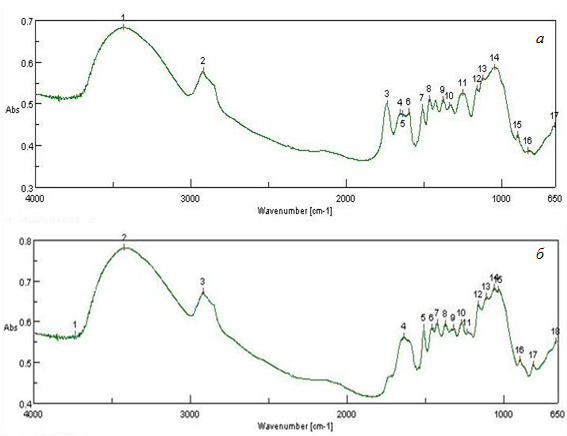INFRARED SPECTROSCOPY OF WOOD OF PINE, BIRCH AND OAK, MODIFIED WITH MONOETHANOLA-MINE(N→B)THREEHYDROXYBORATE
Abstract
The article presents the results of IR-spectroscopic study of wood of pine, birch and oak, modified with 50% aqueous solution of monoethanolamine(N→B)threehydroxyborate. IR spectra of the samples of birch and oak, modified by monoethanolamine(N→B)threehydroxyborate havebeen obtained for the first time. It was found that the modifier chemically interacts at room temperature with the reactive groups of the tree species under study; the chemical bonds being formed are hydrolytically stable. It is revealed that the change in the supramolecular structure of the modified wood is associated with a change in the system of hydrogen bonds. It is shown that the in the case of modifyingwith monoethanolamine(N→B)threehydroxyborate, there is no destruction of the aromatic rings of lignin, and the main chains of the macromolecules of cellulose, i.e. modifying is in "soft" conditions. It was found that the modifier interacts with the primary hydroxyl groups of cellulose and carboxyl groups of lignin in the modification of pine wood; when modifying, the wood of birch and oak monoethanolamine(N→B)threehydroxyborate mainly interacts with the carboxyl groups of lignin. The density of the grafting modifier depends on the availability of reactive groups of wood composite, and it decreases with increasing the density of wood. Taking into account that surface grafted compounds determine many properties of wood (specific surface area, water absorption, swelling, bio- and fire-resistance), different grafting density and surface distribution of grafted molecules of modifiers on the surface of wood samples under study will lead to differences in the listed properties of the modified wood materials.
Downloads
Metrics
References
Koteneva I.V. Borazotnyye modifikatory poverkhnosti dlya zashchity drevesiny stroitel'nykh konstruktsiy. [Boronotnye surface modifiers for the protection of wood building structures]. Moscow, 2011, 191 p. (in Russ.).
Pokrovskaya Ye.N. Sokhraneniye pamyatnikov derevyannogo zodchestva s pomoshch'yu elementorganicheskikh soyedineniy. [Preservation of monuments of wooden architecture with the help of organo-organic compounds]. Moscow, 2009, 136 p. (in Russ.).
Kotlyarova I.A., Stepina I.V. Vestnik tekhnologicheskogo universiteta, 2018, no. 6, pp. 87–92. (in Russ.).
Bazarnova N.G., Karpova Ye.V., Katrakov I.B. Metody issledovaniya drevesiny i yeye proizvodnykh. [Methods for studying wood and its derivatives]. Barnaul, 2002, 160 p. (in Russ.).
Storodubtseva T.N., Nikulin S.S., Gubin A.S. Lesotekhnicheskiy zhurnal, 2017, no. 2, pp. 148–154. (in Russ.).
Korinova V.Yu., Bazarnova N.G., Ol'khov Yu.A. Khimiya rastitel'nogo syr'ya, 2003, no. 4, pp. 17–24. (in Russ.).
Khviyuzov S.S., Bogolitsyn K.G., Gusakova M.A., Zubov I.N. Fundamental'nyye issledovaniya, 2015, no. 9–1, pp. 87–90. (in Russ.).
Derkacheva O., Sukhov D. Macromolecular Symposia, 2008, vol. 265, no. 1, pp. 61–68.
Lin S.Y., Dence C.W. Methods in Lignin Chemistry, Berlin: Springer-Verlag, 1992, 578 p.
Bazarnova N.G., Korinova V.Yu. Khimiya rastitel'nogo syr'ya, 2000, no. 4, pp. 103–104. (in Russ.).
Fengel' D., Vegener G. Drevesina (khimiya, ul'trastruktura, reaktsii). [Wood (chemistry, ultrastructure, reactions)]. Moscow, 1988, 512 p. (in Russ.).
Ivanov-Omskiy V.I., Gerasyuta S.M., Ivanova Ye.I. Izvestiya Sankt-Peterburgskoy lesotekhnicheskoy akademii, 2017, no. 218, pp. 199–210. (in Russ.).
Mamleyeva N.A., Autlov S.A., Bazarnova N.G., Lunin V.V. Khimiya rastitel'nogo syr'ya, 2015, no. 4, pp. 5–13. (in Russ.).
Kazitsyna L.A., Kupletskaya N.B. Primeneniye UF-, IK- i YaMR-spektroskopii v organicheskoy khimii. [The use of UV, IR and NMR spectroscopy in organic chemistry.]. Moscow, 1971, 264 p. (in Russ.).
Romanchuk N.I., Grekhova I.V. Agrarnyy vestnik Urala, 2008, no. 6(48), pp. 40–42. (in Russ.).
Karpova Ye.V., Bazarnova N.G., Mamatyuk V.I. Khimiya rastitel'nogo syr'ya, 2002, no. 2, pp. 33–38. (in Russ.).
Kireyev V.V. Vysokomolekulyarnyye soyedineniya. [High molecular weight compounds]. Moscow, 2013, 602 p. (in Russ.).
Alekperov E.R., Reznik A.M. Kompleksy bora: sintez, primeneniye. [Boron complexes: synthesis, application]. Mos-cow, 2000, 208 p. (in Russ.).
Tyut'kova Ye.A., Loskutov S.R., Shestakov N.P. Khvoynyye boreal'nyye lesa, 2017, vol. XXXV, no. 3–4, pp. 61–67. (in Russ.).
Nakamoto K. IK-spektry i spektry KR neorganicheskikh i koordinatsionnykh soyedineniy. [IR spectra and Raman spectra of inorganic and coordination compounds]. Moscow, 1991, 536 p. (in Russ.).
Nedelina N.Yu. Nauchnyy zhurnal KubGAU, 2013, no. 89, URL: http://ej.kubagro.ru/2013/05/pdf/03.pdf (in Russ.).


This work is licensed under a Creative Commons Attribution 4.0 International License.
The authors, which are published in this journal, agree to the following conditions:
1. Authors retain the copyright to the work and transfer to the journal the right of the first publication along with the work, at the same time licensing it under the terms of the Creative Commons Attribution License, which allows others to distribute this work with the obligatory indication of the authorship of this work and a link to the original publication in this journal .
2. The authors retain the right to enter into separate, additional contractual agreements for the non-exclusive distribution of the version of the work published by this journal (for example, to place it in the university depository or to publish it in a book), with reference to the original publication in this journal.
3. Authors are allowed to post their work on the Internet (for example, in a university repository or on their personal website) before and during the review process of this journal, as this may lead to a productive discussion, as well as more links to this published work.











